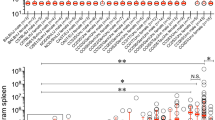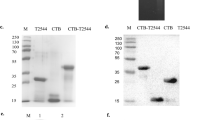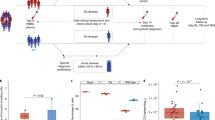Abstract
ALTHOUGH previous specific active or passive immunization may prolong slightly the survival-time of mice infected with mouse-pathogenic Solmonellæ (for example, Salm. typhimurium, Salm. enteritidis), the number of long-term survivors is but little improved1–3. Similarly, attempts to enhance resistance against mouse typhoid non-specifically, either by previous infection with Mycobacterium tuberculosis (strain BCG)4 or by injections of lipid A from Gramnegative bacteria5, have also met with only limited success. On the other hand, Hobson3 showed that mice were highly resistant to virulent Salm. typhimurium, in terms of survival, if they had been infected previously with an avirulent variant of the same species. As Salm. typhimurium is a reticulo-endothelial parasite in mice, like Myco. tuberculosis and Brucella abortus, the possibility arises that this greatly increased resistance might resemble the cellular antibacterial immunity mechanism inferred from investigations with these latter microorganisms6–8. Evidence has been obtained, however, both from in vitro macrophage studies and mouse infection experiments, which suggests that ‘cellular immunity’ following infection with Myco. tuberculosis cross-reacts against Brucellæ and vice versa9–12. The present communication illustrates that there is also a considerable non-specific element in the resistance produced by avirulent Salm. typhimurium, for this has been found to be effective against a heterologous Salmonella infection. Salm. enteritidis was considered unsuitable for use in this role as it shares somatic antigen components with Salm. typhimurium. Instead, Salm. paratyphi C (6,7,Vi : c : 1,5) was selected as it shares only one second-phase flagellar antigen with Salm. typhimurium (1,4,5,12 : i : 1,2) and, although not a natural mouse pathogen, produces an experimental infection similar to mouse typhoid.
This is a preview of subscription content, access via your institution
Access options
Subscribe to this journal
Receive 51 print issues and online access
$199.00 per year
only $3.90 per issue
Buy this article
- Purchase on Springer Link
- Instant access to full article PDF
Prices may be subject to local taxes which are calculated during checkout
Similar content being viewed by others
References
Greenwood, M., Topley, W. W. C., and Wilson, J., J. Hyg. (Camb.), 31, 257 (1931).
Hobson, D., J. Path. Bact., 73, 399 (1957).
Hobson, D., J. Hyg. (Camb.), 55, 334 (1957).
Howard, J. G., Biozzi, G., Halpern, B. N., Stiffel, C., and Mouton, D., Brit. J. Exp. Path., 40, 281 (1959).
Howard, J. G., Rowley, D., and Wardlaw, A. C., Nature, 179, 314 (1957).
Lurie, M. B., J. Exp. Med., 75, 247 (1942).
Suter, E., J. Exp. Med., 97, 235 (1953).
Pomales-Lebrón, A., and Stinebring, W. R., Proc. Soc. Exp. Biol., N.Y., 94, 78 (1957).
Elberg, S. S., Schneider, P., and Fong, J., J. Exp. Med., 106, 545 (1957).
Pullinger, E. J., J. Hyg. (Camb.), 36, 456 (1936).
Nyka, W., Amer. Rev. Tuberc., 73, 251 (1956).
Henderson, D. W., Lancaster, M. C., Packman, L., and Peacock, S., Brit. J. Exp. Path., 37, 597 (1956).
Biozzi, G., Benacerraf, B., Stiffel, C., and Halpern, B. N., C. R. Soc. Biol. (Paris), 148, 431 (1954).
Archer, G. T. L., and Whitby, J. L., J. Hyg. (Camb.), 55, 513 (1957).
Howard, J. G., M. D. Thesis, University of London (1959).
Biozzi, G. (personal communication).
Author information
Authors and Affiliations
Rights and permissions
About this article
Cite this article
HOWARD, J. Resistance to Infection with Salmonella paratyphi C in Mice parasitized with a Relatively Avirulent Strain of Salmonella typhimurium . Nature 191, 87–88 (1961). https://doi.org/10.1038/191087a0
Issue Date:
DOI: https://doi.org/10.1038/191087a0
This article is cited by
-
SPC-P1: a pathogenicity-associated prophage of Salmonella paratyphi C
BMC Genomics (2010)
Comments
By submitting a comment you agree to abide by our Terms and Community Guidelines. If you find something abusive or that does not comply with our terms or guidelines please flag it as inappropriate.



